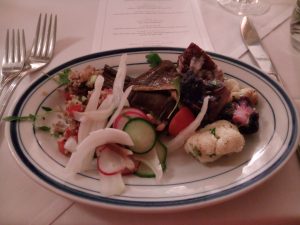Rose’ sales continue to soar throughout the world. Given the figures, it seems that almost everyone who is into wine these days is into rosé. Rose’ is produced throughout the world, but Provence remains at the top. But there is no denying that come fall, many of the same wine drinkers who loved their rosé, tend to put away the pink they loved all summer in favor of red wines. Kind of sounds like the old rule about not wearing white after Labor Day right? But why stop drinking a wine you love just because summer is over? Considering that rosé is made from both white and red grapes, comes in sparkling and still varieties, and the fact that many white wine drinkers continue to drink their favorite white long after summer has come and gone while those who favor red usually drink it throughout the year, why not rosé for all seasons?
Rosé is produced all over the world. Since rosé is made from a variety of white as well as red grapes, its flavor profile can range from light, crisp and acidic, with fresh notes of citrus and strawberry, to floral and soft, with ripe orchard fruit, berry and honey elements. The color of rosé can also vary broadly. Some are so pale as to be barely distinguishable from a Sauvignon Blanc, while others can easily be mistaken for a red wine. However, if a particular region can be said to represent the standard for quality rosé, then it has to be Provence in Southern France.
France has been producing rosé for twenty six centuries, ever since the ancient Greeks settled in what is now Marseilles over two thousand years ago. The color of any wine is largely determined by the grape variety, the terroir, the style of wine making and the length of maceration or how long the juice stays in contact with its skins during the production process. The ancient Greeks apparently did not allow the skins to steep in its juice for very long. The result? Rosé. Nevertheless, rosé wine making in Provence has evolved considerably in the past two millennia.
Provence currently produces thirty nine percent of the Appellation d’origine contrôlée (AOC) rosés in France. The AOC designation guarantees place of origin and quality of production. The two methods of rosé production used in Provence include dir ect pressing and maceration. The first method involves pressing the grapes directly after harvest. This method yields a delicate pale pink hue that is synonymous with the typical color of a Provence style rosé. Maceration is the process by which the juice is kept in contact with the skins for a length of time before being drained off. The maceration duration for rosés ranges between two and twenty hours. The longer the maceration time the deeper the color of the resulting wine.



Everyone knows rosé is a perfect wine for drinking on its own in summertime preferably on a rooftop, terrace of patio. But rosé is also a great wine pairing candidate for a variety of cuisines in any season. It runs the gamut of flavor profiles, styles and color making it equally adaptable to raw, roasted or grilled seafood and vegetables, or to hearty pastas and seared meats. Rosé also make great complements to fruity and buttery desserts and confections.
Some Rose’s from Provence worth considering in all seasons:

Château Gassier 946 Rosé, 2015
Soft, floral and full of ripe strawberry, berry and citrus fruit notes.
( A part of this wine is aged in new Austrian oak.)

Chateau Saint Maur Clos de Capelune Rosé, 2014
Fresh and soft, with balanced citrus, strawberry and berry fruit notes, and a mild lingering finish.

Chateau de Pampelonne Rosé, 2015
Crisp, with balanced acidity and ripe fruit flavors, and a smooth finish.

Chateau d Esclans Garrus Rosé, 2013
Complex, with floral aromas, concentrated citrus fruit, strawberry, raspberry, and balanced mineral notes and a touch of oak.
(This one has a pale straw colored hue and is aged in oak barrels. Rosé is is usually aged in stainless steel tanks.)

Be First to Comment